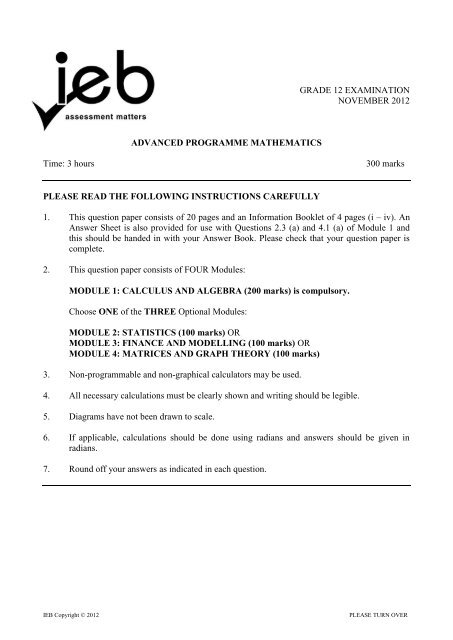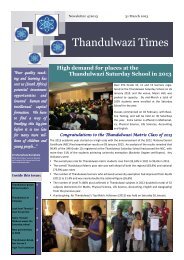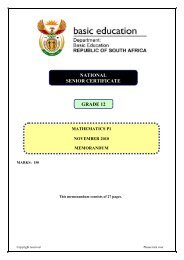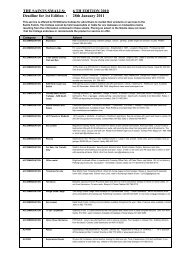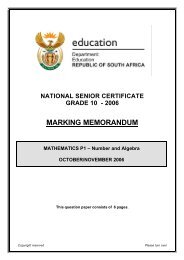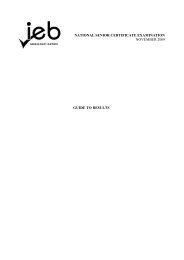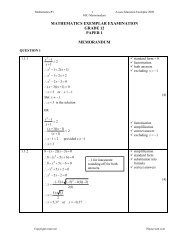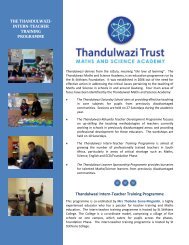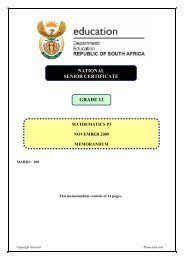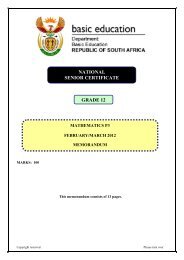AP Maths Final
AP Maths Final
AP Maths Final
You also want an ePaper? Increase the reach of your titles
YUMPU automatically turns print PDFs into web optimized ePapers that Google loves.
GRADE 12 EXAMINATION<br />
NOVEMBER 2012<br />
ADVANCED PROGRAMME MATHEMATICS<br />
Time: 3 hours<br />
300 marks<br />
PLEASE READ THE FOLLOWING INSTRUCTIONS CAREFULLY<br />
1. This question paper consists of 20 pages and an Information Booklet of 4 pages (i – iv). An<br />
Answer Sheet is also provided for use with Questions 2.3 (a) and 4.1 (a) of Module 1 and<br />
this should be handed in with your Answer Book. Please check that your question paper is<br />
complete.<br />
2. This question paper consists of FOUR Modules:<br />
MODULE 1: CALCULUS AND ALGEBRA (200 marks) is compulsory.<br />
Choose ONE of the THREE Optional Modules:<br />
MODULE 2: STATISTICS (100 marks) OR<br />
MODULE 3: FINANCE AND MODELLING (100 marks) OR<br />
MODULE 4: MATRICES AND GR<strong>AP</strong>H THEORY (100 marks)<br />
3. Non-programmable and non-graphical calculators may be used.<br />
4. All necessary calculations must be clearly shown and writing should be legible.<br />
5. Diagrams have not been drawn to scale.<br />
6. If applicable, calculations should be done using radians and answers should be given in<br />
radians.<br />
7. Round off your answers as indicated in each question.<br />
IEB Copyright © 2012<br />
PLEASE TURN OVER
GRADE 12 EXAMINATION: ADVANCED PROGRAMME MATHEMATICS Page 2 of 20<br />
MODULE 1<br />
CALCULUS AND ALGEBRA<br />
QUESTION 1<br />
n<br />
Prove by induction that 9 8n<br />
1 is divisible by 8 for all natural values of n, with n 1.<br />
[14]<br />
QUESTION 2<br />
2.1 Solve for x without using a calculator:<br />
<br />
<br />
log x log 2 log x 5 log( x 1).<br />
(6)<br />
2.2 Given f x<br />
1<br />
<br />
1 e<br />
x<br />
(a) Determine whether f( x ) is increasing or decreasing. (3)<br />
(b) What is the range of f( x )?<br />
(4)<br />
(c)<br />
Find an expression for the inverse function<br />
f<br />
1 ( x).<br />
<br />
(4)<br />
2.3 Given: f x<br />
x<br />
<br />
x<br />
if x1<br />
if x 1<br />
and g x ln<br />
x<br />
(a) Sketch the graph of f on the Answer Sheet provided. (4)<br />
(b) Determine the domain of g f ( x ) .<br />
(4)<br />
[25]<br />
QUESTION 3<br />
3.1 It is given that x a bi<br />
satisfies the equation: (2 i)( x 3 i) 8i<br />
6.<br />
Find the values of a and b. (7)<br />
3.2 Find the value of k if<br />
5 13 0 and x2 3i<br />
is a root of the equation. (8)<br />
[15]<br />
3 2<br />
x x kx<br />
IEB Copyright © 2012
GRADE 12 EXAMINATION: ADVANCED PROGRAMME MATHEMATICS Page 3 of 20<br />
QUESTION 4<br />
<br />
4.1 Jamie is playing on his calculator and he notices that sin sin . He tries this<br />
4 4<br />
<br />
for , and 4 and now he believes that he has discovered a new trigonometry<br />
2 5<br />
identity: sin x sin x.<br />
(a) Draw the graphs g( x) sin x<br />
and hx sin<br />
x on the interval 0 x<br />
2 .<br />
Use the Answer Sheet provided. (8)<br />
(b) Explain Jamie's mistake in thinking that sin x is always equal to sin x . (2)<br />
4.2 Given: <br />
<br />
<br />
<br />
px<br />
if 0 x <br />
<br />
3<br />
f x 2cos x if x <br />
<br />
2<br />
2<br />
1 5<br />
<br />
3<br />
x 2 if x<br />
2 <br />
2<br />
(a) (i) Determine the value of p such that f is continuous at x .<br />
(You do<br />
NOT need to use first principles.) (4)<br />
(ii)<br />
Determine whether f is continuous at<br />
3 <br />
x .<br />
(5)<br />
2<br />
(b) (i) Either by means of a sketch or algebraically, explain why f cannot be<br />
differentiable at x for the value of p found in Question 4.2 (a)(i). (5)<br />
(ii)<br />
Determine<br />
lim f '( x)<br />
3 <br />
<br />
x <br />
2 <br />
and<br />
lim f '( x).<br />
<br />
x <br />
<br />
3 <br />
<br />
<br />
2 <br />
(6)<br />
(iii)<br />
Is f differentiable at<br />
3 <br />
x ? Give a reason for your answer. (2)<br />
2<br />
[32]<br />
IEB Copyright © 2012<br />
PLEASE TURN OVER
GRADE 12 EXAMINATION: ADVANCED PROGRAMME MATHEMATICS Page 4 of 20<br />
QUESTION 5<br />
x<br />
5.1 Below is the graph of f( x) .<br />
lnx<br />
(a) Explain why there is no graph to the left of the y-axis. (2)<br />
(b) State the equation of the vertical asymptote of the graph. (2)<br />
(c)<br />
d 1<br />
Given that ln x , find the coordinates of the turning point of the<br />
dx x<br />
graph. (8)<br />
5.2 Given the function f x<br />
<br />
2<br />
2x<br />
2x5<br />
x 1<br />
(a) Determine the equation of the oblique asymptote of the graph of f .<br />
(6)<br />
(b) Does the oblique asymptote intercept the graph? Motivate your answer. (3)<br />
[21]<br />
IEB Copyright © 2012
GRADE 12 EXAMINATION: ADVANCED PROGRAMME MATHEMATICS Page 5 of 20<br />
QUESTION 6<br />
Use a Riemann Sum to determine the area between the curves <br />
2<br />
x-axis on the interval x [0;3] as indicated on the graph below.<br />
f x 3x<br />
1 and the<br />
[14]<br />
QUESTION 7<br />
A circle is shown below. CD is perpendicular to AB and when CD is extended it passes<br />
through the centre O of the circle. D is the midpoint of AB and the lengths of CD and AB<br />
are 6 cm and 30 cm respectively.<br />
7.1 Show that the radius of the circle is 21,75 cm. (6)<br />
7.2 Determine the arc length ACB, correct to 4 decimal places. (5)<br />
7.3 Calculate the area of the segment ACBD, correct to 4 decimal places. (5)<br />
[16]<br />
IEB Copyright © 2012<br />
PLEASE TURN OVER
GRADE 12 EXAMINATION: ADVANCED PROGRAMME MATHEMATICS Page 6 of 20<br />
QUESTION 8<br />
The equation<br />
3 2 3<br />
x 3xy y 1 defines y as a function of x.<br />
8.1 Verify that (2 ; –1) is a point on the curve. (2)<br />
dy<br />
8.2 Determine .<br />
dx<br />
(8)<br />
8.3 Hence find the equation of the tangent at (2 ; –1). (5)<br />
[15]<br />
QUESTION 9<br />
Find the following integrals:<br />
9.1<br />
3 2<br />
x 1<br />
2x<br />
sec <br />
dx<br />
(6)<br />
2<br />
3<br />
<br />
<br />
x<br />
x dx<br />
(7)<br />
2<br />
9.2 (cos 3 x ) sin3<br />
<br />
9.3 cos 4 .sin5 d<br />
(6)<br />
9.4 y y 3 dy<br />
(9)<br />
[28]<br />
IEB Copyright © 2012
GRADE 12 EXAMINATION: ADVANCED PROGRAMME MATHEMATICS Page 7 of 20<br />
QUESTION 10<br />
1<br />
Below is a picture of the graph y . The area bounded by the curve and the lines x 1<br />
x<br />
and x a,<br />
where a 1,<br />
has been rotated about the x-axis.<br />
10.1 Determine the volume of revolution, in terms of a. (8)<br />
10.2 Hence determine the volume of revolution as . (2)<br />
[10]<br />
QUESTION 11<br />
An industrial chimney deposits pollution (soot)<br />
onto the ground. If there are two industrial<br />
chimneys (A and B) that are 15 km apart, the<br />
concentration of soot on the line joining them, at a<br />
distance x from chimney A, is given by:<br />
8k<br />
k<br />
S <br />
x<br />
2<br />
15 x<br />
2<br />
where k is a positive constant.<br />
[]<br />
Find the point on the line joining the two chimneys where the concentration of soot is a<br />
minimum.<br />
[10]<br />
Total for Module 1: 200 marks<br />
IEB Copyright © 2012<br />
PLEASE TURN OVER
GRADE 12 EXAMINATION: ADVANCED PROGRAMME MATHEMATICS Page 8 of 20<br />
MODULE 2<br />
STATISTICS<br />
All answers should be rounded to the fourth decimal place.<br />
QUESTION 1<br />
1.1 A factory makes large quantities of coloured sweets, and it is known on average<br />
that 20% of the sweets are coloured green. A packet contains 20 sweets (a random<br />
sample from the factory). Calculate the probability that exactly seven of the sweets<br />
are green. (6)<br />
1.2 A Comrades runner owns six different pairs of running shoes. Calculate the number<br />
of ways of selecting the following:<br />
(a) 4 shoes from the 12 (1)<br />
(b) 2 left shoes and 2 right shoes (3)<br />
(c) 2 pairs of non-matching shoes (Note: a pair is a left and right shoe) (4)<br />
1.3 Find the number of ways that 9 people can be arranged into three groups of three. (5)<br />
1.4 A batch of 20 integrated circuit chips contains 20% which are defective. A sample<br />
of 10 is drawn at random. What is the probability that at least one of the chips will<br />
be defective? (7)<br />
[26]<br />
QUESTION 2<br />
Scores on an IQ test are normally distributed with a mean of 100 and a standard deviation<br />
of 15.<br />
2.1 It is said that to have superior intelligence, your IQ score must fall within 120 and<br />
129. What percentage of the world's population fall in this category? (10)<br />
2.2 2,2% of the population fall in the lowest category. What IQ score is the maximum<br />
score that would put someone in the lowest category? (6)<br />
[16]<br />
IEB Copyright © 2012
GRADE 12 EXAMINATION: ADVANCED PROGRAMME MATHEMATICS Page 9 of 20<br />
QUESTION 3<br />
Ten learners wrote end-of-term examination papers in <strong>AP</strong> English and French. Their marks,<br />
for <strong>AP</strong> English and for French, are summarised as follows:<br />
<br />
x y x <br />
2<br />
578 607 38378<br />
2<br />
y<br />
<br />
41221 xy 39070<br />
3.1 Calculate the mean mark for <strong>AP</strong> English and French. (2)<br />
3.2 Hence, calculate the equation of the regression line y on x. (6)<br />
3.3 Calculate the correlation coefficient between <strong>AP</strong> English and French. The formula<br />
to calculate the correlation coefficient is as follows:<br />
r <br />
nxy xy<br />
2 2<br />
<br />
<br />
2 2<br />
<br />
n x x n y y<br />
<br />
(3)<br />
Two other students, Allie and Danny, were each absent from one examination paper. Allie<br />
scored 85 in <strong>AP</strong> English but was absent for French, and Danny scored 65 in French but was<br />
absent for <strong>AP</strong> English.<br />
3.4 State for which learner it would be appropriate to use the regression line calculated<br />
above to estimate a mark for the examination paper for which the learner was<br />
absent. Calculate the estimated mark. (3)<br />
3.5 Comment briefly on the reliability of this estimated mark. (2)<br />
[16]<br />
IEB Copyright © 2012<br />
PLEASE TURN OVER
GRADE 12 EXAMINATION: ADVANCED PROGRAMME MATHEMATICS Page 10 of 20<br />
QUESTION 4<br />
4.1 Professor Dayle Vadi claims: "Despite increased law enforcement efforts, rhino<br />
poaching has been increasing by an average of at least 10 rhino per province per<br />
year in South Africa."<br />
The table below is a breakdown of the number of rhinos poached per province for<br />
five different regions for the sample years 2010 and 2011.<br />
Province 2010 2011<br />
Kruger National Park 146 252<br />
North West 57 22<br />
Limpopo 52 73<br />
Kwa-Zulu Natal 38 34<br />
Mpumalanga 17 31<br />
(a)<br />
(b)<br />
Calculate the mean and standard deviation (to one decimal place) of rhinos<br />
poached per province for the years 2010 and 2011. (Treat the Kruger<br />
National Park as a separate province.) (4)<br />
Hence, set up a formal hypothesis test at the 10% level of significance to test<br />
Professor Vadi's claim. (Assume the sample comes from a normal<br />
distribution.) (10)<br />
4.2 A national safety council wants to estimate the proportion of car accidents that<br />
involve pedestrians. How large a sample of accident records must be examined to<br />
be 94% confident that the estimate does not differ from the true proportion by more<br />
than 0,04? The proportion estimated is 0,25. (6)<br />
[20]<br />
QUESTION 5<br />
A survey was undertaken at Aphane High School to determine the proportion of learners<br />
that had Facebook and Twitter accounts. A random sample showed the following:<br />
If a learner had a Twitter account then they also had a Facebook account.<br />
If a learner didn't have a Twitter account, then there was a 90% chance they had a<br />
Facebook account.<br />
The probability that they had a Twitter account was 0,36.<br />
5.1 Draw a Venn diagram depicting the information given above. (10)<br />
5.2 Calculate:<br />
(a) The probability of having a Facebook account. (2)<br />
(b) The probability of having neither a Facebook account nor a Twitter account. (1)<br />
[13]<br />
IEB Copyright © 2012
GRADE 12 EXAMINATION: ADVANCED PROGRAMME MATHEMATICS Page 11 of 20<br />
QUESTION 6<br />
Two learners, Alicia and Rae at Faul School obtained 98% and 40% respectively for<br />
Mathematics at the end of the year. The group average for that particular grade was 56%<br />
with a standard deviation of 18%, which was considered to be too low. The average was<br />
adjusted to 60% with a standard deviation of 12%.<br />
6.1 Calculate how many standard deviations Alicia and Rae's marks are from the<br />
original mean. (2)<br />
6.2 Hence, calculate their new marks once the adjustment has been made. (6)<br />
6.3 Suggest a plausible reason why the standard deviation was lowered. (1)<br />
[9]<br />
Total for Module 2: 100 marks<br />
IEB Copyright © 2012<br />
PLEASE TURN OVER
GRADE 12 EXAMINATION: ADVANCED PROGRAMME MATHEMATICS Page 12 of 20<br />
MODULE 3<br />
FINANCE AND MODELLING<br />
QUESTION 1<br />
1.1 Ihsaan's friends and family gave him cash for his eighteenth birthday present. He<br />
plans to invest this amount, which comes to R5 600, at an annual interest rate of<br />
6,84%, compounded quarterly. Calculate the interest this once-off investment will<br />
earn over five years. (4)<br />
1.2 Rose deposits money at the end of each quarter in a savings account that also earns<br />
an annual interest rate of 6,84%, compounded quarterly. Calculate the value of her<br />
equal quarterly deposits if this account accrues to R10 033,38 over a five-year<br />
period. (6)<br />
1.3 Solly deposits R420 at the end of every quarter in a savings account that also earns<br />
an annual interest rate of 6,84%. However, with the bank he has chosen, interest is<br />
compounded monthly. Calculate the value to which his investments will accrue over<br />
a five-year period. (10)<br />
[20]<br />
QUESTION 2<br />
During the first two years of the lifespan of a new car, depreciation in its value is usually<br />
quite high at 12% per annum. During the third year, depreciation is slightly lower at 10,5%.<br />
For the fourth, fifth and sixth years, depreciation remains constant.<br />
The annual rate of depreciation over the first 6 years of the lifespan of a car is shown in the<br />
table below:<br />
Year 1 2 3 4 5 6<br />
Rate of depreciation 12% 12% 10,5% x % x % x %<br />
Calculate x if the average annual rate of depreciation over the 6 years is 10% per annum.<br />
Give your answer as a percentage, correct to two decimal places.<br />
[8]<br />
QUESTION 3<br />
Andile secures a home loan for R850 000 from a bank at an annual interest rate of 8,56%,<br />
compounded monthly. He agrees to repay R7 400 per month at the end of every month.<br />
3.1 Calculate the expected outstanding balance on the loan immediately after the 80 th<br />
payment. (8)<br />
3.2 In addition to his monthly repayments, Andile on two occasions deposited his<br />
annual bonus into this account to offset his home loan. These deposits of R12 000<br />
each coincided with the 17 th and 65 th payments. Calculate the new outstanding<br />
balance on the loan immediately after the 80 th payment. (8)<br />
3.3 After the 80 th payment, Andile calculates that if he lowers his payment to R7 100<br />
per month, he could pay off his bond after a further 160 payments, the last of which<br />
will be less than R7 100. Assuming that the outstanding balance after the 80 th<br />
payment is R675 000, calculate the value of the final payment. (10)<br />
[26]<br />
IEB Copyright © 2012
GRADE 12 EXAMINATION: ADVANCED PROGRAMME MATHEMATICS Page 13 of 20<br />
QUESTION 4<br />
According to Discovery Channel's NatGeo Wild, wild hogs in North America are causing<br />
millions of dollars worth of damage to agricultural land every year. Despite their trail of<br />
destruction, they are surprisingly difficult to track down. They can feed on almost anything<br />
from roots to rubbish, and don't seem to be preyed on by other animals.<br />
A sow (female hog) has three litters a year, each with an average size of four piglets, 60%<br />
of whom will be female. The survival rate of the piglets is high at 80%. The average hog<br />
lives for about seven years in the wild.<br />
4.1 Calculate the annual growth rate of the wild hogs, correct to three decimal places. (6)<br />
4.2 Express the growth in the hog population as a recursive formula, using an annual<br />
growth rate of 5,6 hogs per annum. (2)<br />
4.3 Calculate the hog population after two years, if there are currently 25 hogs on the<br />
farm. Use an annual growth rate of 5,6 hogs per annum. (2)<br />
4.4 The farmer decides to start exterminating the hogs immediately on a weekly basis.<br />
Calculate the minimum number of hogs he needs to kill per week for the next year,<br />
just to keep the number of hogs approximately at their present level. Show suitable<br />
calculations to support your answer, rounded to the nearest whole number. (6)<br />
[16]<br />
IEB Copyright © 2012<br />
PLEASE TURN OVER
GRADE 12 EXAMINATION: ADVANCED PROGRAMME MATHEMATICS Page 14 of 20<br />
QUESTION 5<br />
Okapuka is a 10 000 hectare private game farm just 20 km outside Windhoek, Namibia. It<br />
is home to a variety of animals, including several antelope species that together have a<br />
population of about 4 500. Game rangers have studied leopard tracks, and they estimate<br />
that there are 30 leopards in the more mountainous regions of the farm.<br />
5.1 The phase plot below represents the predicted populations of leopards and antelope<br />
over the next century at Okapuka.<br />
70<br />
PREDICTED POPULATIONS OF<br />
LEOPARDS AND ANTELOPE<br />
60<br />
L<br />
E<br />
O<br />
P<br />
A<br />
R<br />
D<br />
S<br />
50<br />
40<br />
30<br />
20<br />
10<br />
0<br />
0 1000 2000 3000 4000 5000<br />
ANTELOPE<br />
(a) Read off the equilibrium populations for each species. (2)<br />
(b)<br />
(c)<br />
(d)<br />
(e)<br />
Give the range of the leopard population when the antelope population is<br />
increasing for the first time. (2)<br />
Read off the approximate antelope population when the leopard population<br />
is decreasing most rapidly. (2)<br />
In the first year of this model, leopards killed about 420 antelope. Calculate<br />
the value of the parameter b in the predator-prey formula (correct to five<br />
decimal places). (5)<br />
In the first year of this model, four leopard cubs survived. Calculate the<br />
value of the parameter f in the predator-prey formula (correct to five<br />
decimal places), using b = 0,003. (5)<br />
IEB Copyright © 2012
GRADE 12 EXAMINATION: ADVANCED PROGRAMME MATHEMATICS Page 15 of 20<br />
5.2 The Okapuka Game Farm is considering buying hundreds of hectares of adjacent<br />
land. By doing this it can extend its current borders and will substantially increase<br />
the carrying capacity of antelope. The phase plot below represents the new<br />
predicted populations of antelope and leopards over the next century.<br />
90<br />
PREDICTED POPULATION OF<br />
LEOPARDS AND ANTELOPE<br />
80<br />
70<br />
L<br />
E<br />
O<br />
P<br />
A<br />
R<br />
D<br />
S<br />
60<br />
50<br />
40<br />
30<br />
20<br />
10<br />
0<br />
0 1000 2000 3000 4000 5000 6000<br />
ANTELOPE<br />
Compare this phase plot with that in Question 5.1 and then comment on the<br />
following aspects:<br />
(a) the manner in which the initial population of each species changes. (2)<br />
(b) the population range of each species. (2)<br />
(c) the rate at which the equilibrium point is reached. (2)<br />
[22]<br />
IEB Copyright © 2012<br />
PLEASE TURN OVER
GRADE 12 EXAMINATION: ADVANCED PROGRAMME MATHEMATICS Page 16 of 20<br />
QUESTION 6<br />
Von Koch's Snowflake is a well-known fractal, based on a recursive theme.<br />
Step 1: length 27 units<br />
Step 2: length 36 units<br />
This is obtained by the original line segment in Step 1 being trisected.<br />
On the middle of the three sections an equilateral triangle has been constructed.<br />
Step 3: length 48 units<br />
This is obtained by each of the four line segments in Step 2 again being trisected. On each<br />
of the middle sections of each of the four line segments in Step 2 another equilateral<br />
triangle has been constructed.<br />
6.1 Write down a first order recursive formula that represents the length of the n th<br />
fractal shape. (4)<br />
6.2 Determine which step will be the first where the length exceeds 1 000 units. Also<br />
give this length, correct to three decimal places. (4)<br />
[8]<br />
Total for Module 3: 100 marks<br />
IEB Copyright © 2012
GRADE 12 EXAMINATION: ADVANCED PROGRAMME MATHEMATICS Page 17 of 20<br />
MODULE 4<br />
MATRICES AND GR<strong>AP</strong>H THEORY<br />
QUESTION 1<br />
Three matrices L<br />
2 5 0<br />
<br />
1 2 7 , M 6 2<br />
<br />
3 1 , and N 5 2<br />
<br />
2 3 are given.<br />
1.1 Calculate 2M – 3N. (4)<br />
1.2 Explain in words why L has no inverse. (2)<br />
1.3 Explain in words why M has no inverse. (2)<br />
1.4 Write down the inverse of N, with integer values for the elements of the matrix. (4)<br />
[12]<br />
QUESTION 2<br />
2.1 The coordinates of the endpoints of a line segment in a Cartesian plane are (2 ; –4)<br />
and (2 ; 5). The line segment is to be transformed by a shear of factor 3, with the<br />
x-axis as the invariant line. Calculate the coordinates of the endpoints of the line<br />
segment after it has been transformed. (6)<br />
2.2 A figure is to be reflected in the line with equation y = 3x. Give the matrix that will<br />
effect this transformation. The elements of the matrix must be accurate to one<br />
decimal place. (6)<br />
2.3 A figure in a Cartesian plane is to be transformed so that its image has an area three<br />
times the original area. Give two different matrices that could be used to effect this<br />
transformation. The two matrices must represent different types of transformations. (4)<br />
2.4 The point P(25 ; –75) is to be rotated about the origin, so that its image has<br />
coordinates P'(–45 ; 65). Determine the angle of rotation (in degrees and correct to<br />
two decimal places). (8)<br />
[24]<br />
IEB Copyright © 2012<br />
PLEASE TURN OVER
GRADE 12 EXAMINATION: ADVANCED PROGRAMME MATHEMATICS Page 18 of 20<br />
QUESTION 3<br />
3.1 Consider the matrices<br />
1 2 3 8 5 6 <br />
<br />
A 3 2 0 and B 12 10 9<br />
2 1 4 1<br />
5 8 <br />
<br />
Show through calculation that AB BA.<br />
(8)<br />
3.2 A matrix is given in the form<br />
a b c <br />
<br />
d e f<br />
g h i <br />
<br />
Using this matrix, show through calculations that the product of a matrix and its<br />
transpose will always be symmetrical about the leading diagonal.<br />
(Remember: the 'transpose' of a matrix is found by interchanging the rows with the<br />
columns.) (10)<br />
[18]<br />
IEB Copyright © 2012
GRADE 12 EXAMINATION: ADVANCED PROGRAMME MATHEMATICS Page 19 of 20<br />
QUESTION 4<br />
At the world famous Kirstenbosch Botanical Gardens in Cape Town, a section has been<br />
laid out known as the 'Braille Trail'. Visitors are encouraged to experience plant life<br />
through senses other than sight by closing their eyes and to be guided through the Trail by<br />
holding onto ropes.<br />
The graph below (which is not drawn to scale) represents the 'Braille Trail', with vertex A<br />
being both the entrance and exit point to the Trail. The edges of the graph correspond to the<br />
guide-ropes along the lanes, and the weight of the edges to the length of the ropes in<br />
metres.<br />
B<br />
21<br />
C<br />
16<br />
D<br />
A<br />
22<br />
10<br />
17<br />
22<br />
16<br />
21<br />
26<br />
6<br />
E<br />
18<br />
20<br />
J<br />
13<br />
4.1 Officials recommend that the minimum distance a visitor walks should be the<br />
perimeter of the Trail, namely ABCDEFGHJA. This would in effect create a<br />
Hamiltonian Circuit. Explain in words what makes a circuit 'Hamiltonian'. (2)<br />
4.2 To fully experience the Braille Trail, visitors should walk every lane in the Trail.<br />
Design an Eulerian Circuit of minimum length for a visitor to fully experience the<br />
Trail. Clearly state the actual circuit and the length of the circuit. (12)<br />
4.3 Landscapers plan to lay out a new lane that will directly connect C and J. They<br />
decide that, including the new lane CJ, a visitor should not have to walk an Eulerian<br />
Circuit of more than 300 metres. Calculate what the maximum length of the new<br />
lane should be. (10)<br />
[24]<br />
H<br />
7<br />
G<br />
13<br />
F<br />
IEB Copyright © 2012<br />
PLEASE TURN OVER
GRADE 12 EXAMINATION: ADVANCED PROGRAMME MATHEMATICS Page 20 of 20<br />
QUESTION 5<br />
In the graph sketched below a student has started finding a spanning tree of minimum<br />
length. The first three edges she has chosen have been printed in bold.<br />
A<br />
5<br />
10<br />
H<br />
B<br />
9<br />
9<br />
10<br />
8<br />
I<br />
C<br />
x<br />
8 7<br />
J<br />
6<br />
G<br />
5.1 State the number of edges the completed spanning tree will have. (2)<br />
5.2 State whether the student is using Kruskal's or Prim's algorithm. Give a reason for<br />
your answer. (2)<br />
5.3 If DI has to be the next edge selected, state what weight DI must be. (2)<br />
7<br />
5.4 Three edges have a weight of 7. State which of these edges should NOT be selected,<br />
once DI has already been selected. Give a reason for your answer. (2)<br />
5.5 Complete the spanning tree of minimal length for this graph. Assume that the edges<br />
DE, AB, IJ and DI have already been selected. State the length of this minimum<br />
spanning tree. (8)<br />
[16]<br />
9<br />
9<br />
D<br />
10<br />
4<br />
F<br />
7<br />
E<br />
QUESTION 6<br />
In a complete graph every vertex is directly connected to every other vertex. A complete<br />
graph is notated by K n , where n is the number of vertices in the graph.<br />
Some examples of complete graphs are given below:<br />
K 2 has a 1 edge K 3 has 3 edges K 4 has 6 edges K 5 has 10 edges<br />
6.1 State the number of edges in the complete graph K 6 . (3)<br />
6.2 State for which positive integer values of n the complete graph K n will inherently<br />
contain an Eulerian circuit. (3)<br />
[6]<br />
Total for Module 4: 100 marks<br />
IEB Copyright © 2012<br />
Total: 300 marks


